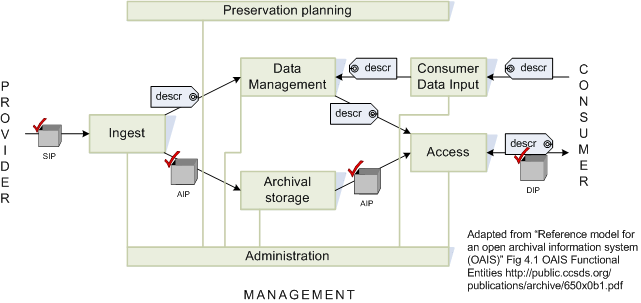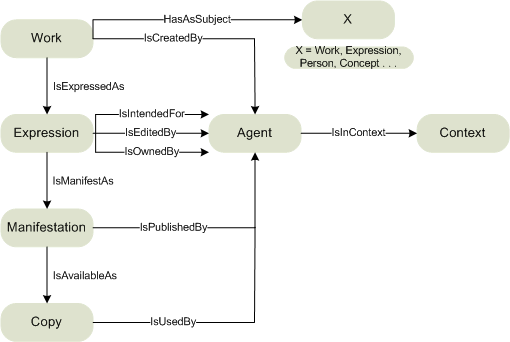Learning Materials Application Profile Pre-draft Domain Model
Version: Draft 1.1, 29 Jan 2008.
Author: Phil Barker
<philb@icbl.hw.ac.uk>
Preamble: about the project
Through the Learning Materials Application Profile (LMAP) scoping study we are investigating metadata application profile requirements for learning materials in relation to digital repositories. The premise of the study that "learning materials" encompass a wide range of resource types each with its own special metadata requirements. Furthermore, factors relating to actions on the resources (e.g. preservation, ensuring accessibility, rights management) will bring their own metadata requirements. The LMAP scoping study will synthesize and analyse the advice about metadata that is currently available to managers of repositories of educational materials. The synthesis will involve asking experts (e.g. JISC advisory services) from each of the various metadata types for their advice; the analysis will seek to relate this advice to a coherent view of the objects being described and the actions taken on them. For more information see the project websitet http://www.icbl.hw.ac.uk/lmap.
Purpose of this document
This document suggests a "straw man" domain model for use during the project which, hopefully, will prove useful in the analysis of the metadata requirements. While it is true that any useful domain model must provide a view of the world that is fit for purpose and widely recognisable, it is not necessary that it be the only view, or even that it be more valid than any other view. Also, since this represents only an incidental output of a short project, the suggested model sketched in outline rather than drawn in full detail.
In keeping with the division of metadata specialities into those relating to content type and those relating to actions, there are two aspects to the suggested domain model, one relating to actions as seen from a repository point of view, the other modelling the content object itself.
If you think I have missed anything or have any other comments please contact me: Phil Barker <philb@icbl.hw.ac.uk>.
Model for actions
The proposed model for actions on the object is adapted from the OAIS Reference Model (pdf), following the evaluation findings by Julie Allinson for the JISC Digital Repositories Support Team that a lighweight version of the OAIS model, with less emphasis on preservation, would provide a reasonable basis for a model of generic repositories. The high level functional entities of the model are depicted below:

The repository system is shown in the centre interacting with three groups or communities: the providers of resources, the consumers or users of resources, and a group responsible for the management of the system. Resources in OAIS are modelled as Information Packages, the details of which are probably not important to LMAP. There are three types of Information Package: the Submission Information Package (SIP) is the resource as received, the Archival Information Package (AIP) is the resource as stored, and the Dissemination Information Package (DIP) is the resource as delivered to the consumer. An easy to understand example of how these may differ in format is the case of an image received in proprietory high resolution format, stored in an open high resolution format, and disseminated in lower resolution or using a lossy compression algorithm.
The system itself comprises the following entities:
- Ingest function
- Involves receiving the resource from the provider and creating the archival information package, including extracting metadata from the submission package and/or creation of metadata on submission.
- Data management function
- Responsible for managing descriptions of the stored resources, ensuring data integrity, perfroming dataset updates including schema updates, and handling queries and the generation of result sets.
- Archival storage function
- Responsible for long term storage and maintence of the archived information packages and providing them for dissemination.
- Access function
- Supports the discovery to delivery process, allowing consumers to appraise the contents of the archive and managing access to copies of resources of interest to them.
- Preservation planning function
- Provides services and functions with the aim of ensuring that the resources in the archive remain available for as long as required even though surrounding computing environment changes.
- Administration function
- Supports the management of the archive, including negotiation with provders and comsumers, auditing, system maintenance.
- Consumer data input function
- This is an additional function not in the OAIS model, which has been included to highlight the concept that consumers may also be providers of information by, for example, reviewing and rating resources, providing contextual usage information, and commenting on and annotating resources or adding their own descriptions or tags. This does not include resubmission of re-purposed objects or contribution of user generated content, since in these cases the user is a content provider rather than consumer.
It is hoped that using this model will help the analysis of the suggested metadata elements by allowing those elements to be related to a repository function that they support and identifying the point in the repository workflow where they may be recorded or generated.
Model for objects
The proposed object model borrows from the scholarly works application profile (SWAP) application model, which in turn is based on the Functional Requirements for Bibliographic Records (FRBR) entity model. The rationale behind this was that, firstly, scholarly works may be considered learning materials in higher education, so any model for learning materials would have to describe scholarly works, secondly, the FRBR model is well-tested and seems generic enough to describe many other types of resource (e.g. musical scores and performances, images, online resources). The model is sketched below:

The "primary entities" on the left model the learning material at various degrees of abstraction; the related entities on the right may also require description in order to support requirements relating to the learning material. The aim in using this model is to be more clear about what precisely is being described by the metadata.
Entities
In more detail the entities are: [comment: I probably need to expand on these explanations -- philb]
- Work
- Taken from FRBR, the work is the most abstract of the primary entities, describing the learning material as an intellectual concept. It may be identified and described, either in free text or by association with its subject (which may be another resource (i.e. a work, an expression ...), a person, an abstract concept, an event or a place).
- Expression
- A FRBR Expression is a realization of the intellectual work in a specific form, as a text, a performance or a presentation. Different revisions or editions of the material are different expressions, as are translations.
- Manifestation
- A FRBR Manifestation is the physical embodiment of an expression a particular medium or format, for example the text as a pdf, HTML, MS Word format, a performance or presentation as an audio/video recording. Metadata that relates to the manifestation will include descriptions of accessibility and technical requirements and affordances.
- Copy
- A copy (using the SWAP term for what FRBR calls an "item"), a single exemplar or instance of a manifestion, is the most concrete of the primary entities. For physical resources, the copy is the individual book, disc or object that can be held and used; for digital resources a copy is less concrete, it is the instatiation of a file or files on a specific systems, e.g. the pdf copy on my computer with my comments, rather than the copy on the server.
- Agent
- FRBR defines several "agent" entities, the Learning Materials model follows SWAP in having a single class of agent entity with the type of any specific agent being defined so that it is appropriate for the relationship of that agent to one of the primary entities. Agent types taken from SWAP include the creator or author of a work, the editor of an expression, and the publisher of a manifestation. From FRBR, an agent may be the subject of a work. Additionally we have the user of a copy (in parallel to the owner of an item in FRBR), the intended audience of an expression and the copyright (and other rights) owner of an expression. Agents may be indivual people or organizations which can be identified by name or represent a class of individuals collectively (e.g. any student in Higher Education). Description of agents is important if one is to be able to identify works by a specific author, or find comments from similar users.
- Context
- This is a new entity not in the FRBR or SWAP models, however existing metadata schema such as the IEEE LOM seem to encapsulate a requirement for resource discovery based on relevancy to specific educational contexts. This is modelled as statement that resource is intended for learners studying Engineering at Higher Education level, where Engineernig at HE is the context.
Relationships
Hopefully the relationships between entities are self explanatory, but some comment on relationships that differ from those in FRBR and SWAP is in order.
The most significant deviation from FRBR is the IsIntendedFor relationship between an expression and an agent. The closest parallel to this relationship in FRBR is the "intended audience" attribute of a work. The reason for the change is that language would seem to be a key element in determining the audience for learning materials, for example in the IEEE LOM standard, element 5.11 educational.language allows one to say that even though a resource is primarily in German, it is intended for English speakers learning German. Thus it seems inappropriate that a learning material work should be translated to give different expressions in different languages that had the same intended audience. It is similarly possible to envisage that a single work might be expressed in different ways to suit audiences of differing educational levels.
Other deviations from FRBR are changes of label to make the terms more relevant to the use of digital learning materials, so IsUsedBy is the FRBR "is owned by"; IsOwnedBy is used to specify the rights owner of an expression [note: that's perhaps confusing?]. Other changes follow SWAP:
- the isExpressedAs relationship is known as 'is realized through' in FRBR
- the isManifestedAs relationship is known as 'is embodied in' in FRBR
- the isAvailableAs relationship is known as 'is exemplified by' in FRBR
- the isCreatedBy relationship is known as 'is created by' in FRBR
- the isPublishedBy relationship is modelled as the 'publisher' attribute of a Manifestation in FRBR
Next steps
Comments and suggestions are welcome. What seems wrong? What needs further explanation?
Hopefully, as the information supplied on metadata requirements is analysed it will be possible to define further the attributes of each entity.